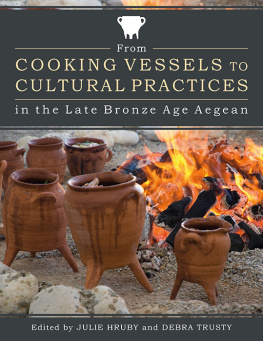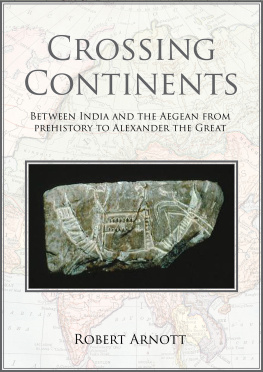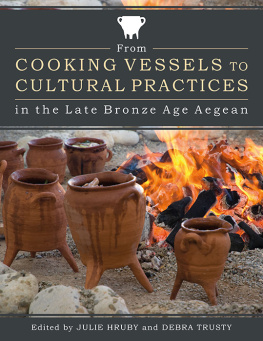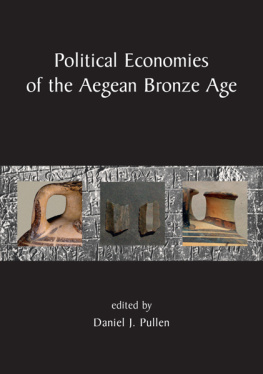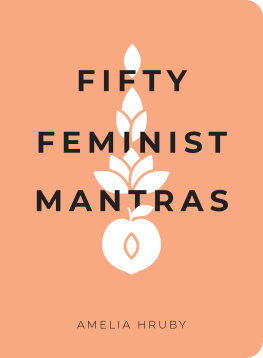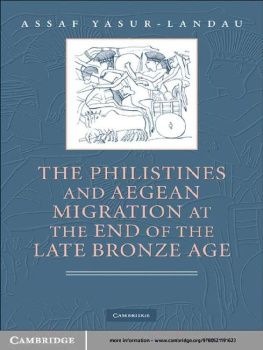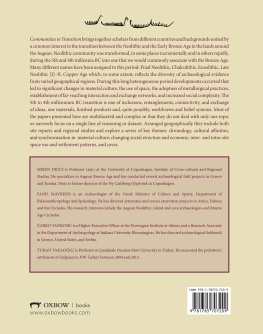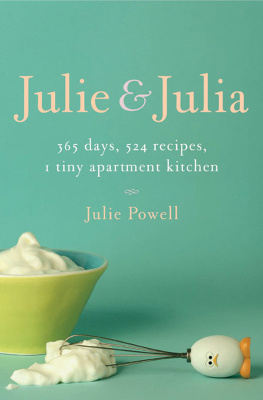Hruby Julie - From Cooking Vessels to Cultural Practices in the Late Bronze Age Aegean
Here you can read online Hruby Julie - From Cooking Vessels to Cultural Practices in the Late Bronze Age Aegean full text of the book (entire story) in english for free. Download pdf and epub, get meaning, cover and reviews about this ebook. year: 2017, publisher: Oxbow Books, Limited, genre: Home and family. Description of the work, (preface) as well as reviews are available. Best literature library LitArk.com created for fans of good reading and offers a wide selection of genres:
Romance novel
Science fiction
Adventure
Detective
Science
History
Home and family
Prose
Art
Politics
Computer
Non-fiction
Religion
Business
Children
Humor
Choose a favorite category and find really read worthwhile books. Enjoy immersion in the world of imagination, feel the emotions of the characters or learn something new for yourself, make an fascinating discovery.
- Book:From Cooking Vessels to Cultural Practices in the Late Bronze Age Aegean
- Author:
- Publisher:Oxbow Books, Limited
- Genre:
- Year:2017
- Rating:5 / 5
- Favourites:Add to favourites
- Your mark:
- 100
- 1
- 2
- 3
- 4
- 5
From Cooking Vessels to Cultural Practices in the Late Bronze Age Aegean: summary, description and annotation
We offer to read an annotation, description, summary or preface (depends on what the author of the book "From Cooking Vessels to Cultural Practices in the Late Bronze Age Aegean" wrote himself). If you haven't found the necessary information about the book — write in the comments, we will try to find it.
Hruby Julie: author's other books
Who wrote From Cooking Vessels to Cultural Practices in the Late Bronze Age Aegean? Find out the surname, the name of the author of the book and a list of all author's works by series.
From Cooking Vessels to Cultural Practices in the Late Bronze Age Aegean — read online for free the complete book (whole text) full work
Below is the text of the book, divided by pages. System saving the place of the last page read, allows you to conveniently read the book "From Cooking Vessels to Cultural Practices in the Late Bronze Age Aegean" online for free, without having to search again every time where you left off. Put a bookmark, and you can go to the page where you finished reading at any time.
Font size:
Interval:
Bookmark:

Published in the United Kingdom in 2017 by
OXBOW BOOKS
The Old Music Hall, 106108 Cowley Road, Oxford OX4 1JE
and in the United States by
OXBOW BOOKS
1950 Lawrence Road, Havertown, PA 19083
Oxbow Books and the individual authors 2017
Paperback Edition: ISBN 978-1-78570-632-5
Digital Edition: ISBN 978-1-78570-633-2 (epub)
A CIP record for this book is available from the British Library and the Library of Congress
All rights reserved. No part of this book may be reproduced or transmitted in any form or by any means, electronic or mechanical including photocopying, recording or by any information storage and retrieval system, without permission from the publisher in writing.
Printed in the United Kingdom by Hobbs the Printers Ltd
Typeset in India by Lapiz Digital Services, Chennai
For a complete list of Oxbow titles, please contact:
UNITED KINGDOM
Oxbow Books
Telephone (01865) 241249, Fax (01865) 794449
Email:
www.oxbowbooks.com
UNITED STATES OF AMERICA
Oxbow Books
Telephone (800) 791-9354, Fax (610) 853-9146
Email:
www.casemateacademic.com/oxbow
Oxbow Books is part of the Casemate Group
Front cover: Minoan-style cooking pots made by Jerolyn Morrison; photo by Chronis Papanikolopoulos
Back cover: Photo by Walter Gauss, digital remastering by Rudolfine Smetana
Debra Trusty and Julie Hruby
Debra Trusty
Julie Hruby
Joann Gulizio and Cynthia W. Shelmerdine
Bartomiej Lis
Walter Gauss, Evangelia Kiriatzi, Michael Lindblom, Bartomiej Lis, and Jerolyn E. Morrison
Evi Gorogianni, Natalie Abell, and Jill Hilditch
Salvatore Vitale and Jerolyn E. Morrison
Jerolyn E. Morrison
Elisabetta Borgna and Sara T. Levi
Reinhard Jung
Michael L. Galaty
The study of the production, trade, and consumption of cooking vessels represents a long-standing lacuna in prehistoric Aegean archaeology. Until recently, cooking vessels were typically mentioned in passing in works that focused primarily on decorated fine ware and other archaeological remains. This volume is an attempt to remedy that situation and is entirely dedicated to the study of prehistoric cooking vessels through comparative methods. It is the product of a panel that was organized by the editors for the 115th Annual Meeting of the Archaeological Institute of America, which took place in January 2014. Since that time, we have added chapters from a selection of other scholars whose work fits well with that of the initial participants.
We would like to thank the many people without whose assistance the production of this volume would have been impossible. All our contributors refereed each others papers. Jeremy Rutter kindly read and provided feedback on the contents of all the papers. Too many people to count, let alone name, have provided stimulating discussions and bibliographic recommendations on the topic. Daniel Pullen provided advice on formatting. E. M. Thompson provided copy editing assistance, and two successive associate deans of the arts and humanities at Dartmouth College, Adrian Randolph and Barbara Will, provided funding that enabled us to hire her. We would also like to thank all the people at Oxbow who have been so patient with our project, including Clare Litt, Julie Gardiner, Mette Bundgaard, Hannah McAdams, and Katie Allen. We both would like to thank our colleagues for their encouragement. Debra would like to express her appreciation for the support of her partner Jason Taber and Julie for her partner, Eric Chatterjee. The editors take full responsibility for whatever flaws inevitably remain.
NATALIE ABELL Department of Classical Studies, University of Michigan, Michigan, USA
ELISABETTA BORGNA Department of History and Preservation of the Cultural Heritage, Universit degli Studi di Udine, Italy
MICHAEL L. GALATY Department of Anthropology and Middle Eastern Cultures, Mississippi State University, USA
WALTER GAUSS Austrian Archaeological Institute at Athens at the Austrian Academy of Sciences, Athens, Greece
EVI GOROGIANNI Department of Anthropology, University of Akron, Ohio, USA
JOANN GULIZIO Department of Classics, The University of Texas at Austin, Texas, USA
JILL HILDITCH Amsterdam Centre for Ancient Studies and Archaeology, Department of Archaeology, University of Amsterdam, The Netherlands
JULIE HRUBY Department of Classics, Dartmouth College, Hanover, New Hampshire, USA
REINHARD JUNG Institute for Oriental and European Archaeology, Austrian Academy of Sciences, Vienna, Austria
EVANGELIA KIRIATZI Fitch Laboratory, British School at Athens, Athens, Greece
SARA T. LEVI Universit degli Studi di Modena e Reggio Emilia, Italy and Hunter College, The City University of New York, USA
MICHAEL LINDBLOM Department of Archaeology and Ancient History, Uppsala University, Uppsala, Sweden
BARTOMIEJ LIS Institute of Archaeology and Ethnology, Polish Academy of Sciences, Warsaw, Poland
JEROLYN E. MORRISON Mediterranean Section, Penn Museum, University of Pennsylvania Museum of Archaeology and Anthropology
CYNTHIA W. SHELMERDINE Department of Classics, The University of Texas at Austin, Austin, Texas, USA
DEBRA TRUSTY Department of Classics, University of Iowa, Iowa City, Iowa, USA
SALVATORE VITALE Department of Civilizations and Forms of Knowledge (Archaeology), University of Pisa, Pisa, Italy
As we brought this volume together, a consensus emerged among the contributors that more attention should be dedicated to Aegean cooking vessels. We maintain that cooking wares reflect economic, political, and social developments, much as painted fine wares do. Additionally, they answer questions about culinary culture that painted fine wares cannot, especially when cooking vessels are examined diachronically, inter-regionally, or in other comparative ways. In this introductory chapter, we discuss some of the obstacles that our contributors have had to overcome, offer some solutions, and suggest future research topics. Our hope is that by recognizing these issues, scholars can begin to collaborate to develop a better understanding of this under-researched class of Bronze Age Aegean functional ceramics.
There is a long history of variability in how archaeologists choose to define, identify, and classify cooking vessels. These pots can be found in categories including coarse ware (French 1961), domestic ware (Blegen 1921; Dalinghaus 1998), unpainted vessels or wares (Blegen 1928; French 1965), plain ware (Wace et al . 1921/19221922/1923), and kitchen fabrics (Catling 2009). Other scholars prefer to separate them entirely from other ceramic fabrics (Stubbings 1947). Michael Galaty, who has also written the concluding piece for this volume, recognized that there is often a very fine line between traditional coarse wares and the fabrics used for cooking functions, a situation that is bound to result in unnecessary confusion (1998, 102). By failing to come to a consensus in our definitions, we have inadvertently impeded our ability to understand the impact such vessels had in the ancient world.
Unfortunately, this situation has not changed, and no unambiguous definition of cooking vessels has been postulated for the Aegean. We would therefore like to begin this volume by proposing a working definition: cooking pots are ceramic vessels designed to resist thermal shock and maintain toughness despite repeated exposure to temperature changes.
Next pageFont size:
Interval:
Bookmark:
Similar books «From Cooking Vessels to Cultural Practices in the Late Bronze Age Aegean»
Look at similar books to From Cooking Vessels to Cultural Practices in the Late Bronze Age Aegean. We have selected literature similar in name and meaning in the hope of providing readers with more options to find new, interesting, not yet read works.
Discussion, reviews of the book From Cooking Vessels to Cultural Practices in the Late Bronze Age Aegean and just readers' own opinions. Leave your comments, write what you think about the work, its meaning or the main characters. Specify what exactly you liked and what you didn't like, and why you think so.

